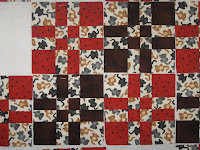Today I had a chance to spend some quality time in the studio and finished a set of scrap blocks, so I thought this would be a good time to post pictures and a tutorial of sorts.
The first step was cutting backing and batting squares.

I had started with some 9-inch squares from another project, and that turned out to be a good size to work with, so I started cutting more of my larger scraps to that size. The batting is also scraps left over from other quilts, and I cut it closer to 10 inches square. The block begins with a backing square turned wrong side up, and a batting square laid across the top of it:

Then comes the fun part - digging into the bin of scraps and pulling out the first strips.

This scrap bin has been going for quite a while, and I had great fun digging down to the bottom to see what treasures were buried down there and then trying to remember what quilt(s) I had used that fabric in. I started with a strip near the center, right side up, then pinned another strip to it, right side down, and stitched thru both strips, the batting, and the backing, thus quilting all the layers together as I stitched the strips together.

Using the sew-and-flip method I worked my way across half the block, then did the same for the other half. I lengthened my stitch just a bit to a 3.0 mm and used a thread that would be appealing on all the fabrics used in the back; in this case, lime green.
When I was done, I had a block that looked like this.

The next step was to run a narrow zig-zag all around the outside edge of the block.

I used a 1.0 mm width and a stitch length of 3.0 mm. With the right toe of the open-toe foot right up against the edge of the fabric, I moved the needle over to the right so that the stitching was right on the edge of the backing fabric. This step accomplishes a couple of things. One is to get those corner pieces, which otherwise want to
flop around and be uncooperative, firmly sewn down. The other is that it compresses the seam allowance, which will make doing the sashing easier.
Then it was time to trim and square up the squares:

I found when I went to do this that my block was now slightly smaller than 9 inches because the stitching had caused it to draw up just a little. Since I was only concerned that the blocks be the same size, and not that they be exactly 9 inches, I just trimmed them to 8 3/4 and was happy with that. If the exact size mattered in a project, I would start with a background square about half an inch larger than that size.
A couple of times when I was digging through the scraps I came across strip sets left over from some other project. I just treated them the same as if they were a single fabric and worked them right in. I even found some orphan blocks that I sewed together into a strip and incorporated. And if I had a piece of fabric I wanted in the center of the block but it wasn't long enough, I sewed another fabric to it and created a custom strip. The only thing I was careful about was making sure the very last strip in the corner wasn't too narrow; I didn't want a lot of seam bulk in that place, or a piece of fabric that was too small to really be seen once the sashing was added to the final blocks.

Once I had the 20 blocks I needed for the quilt finished I put them up on the design wall and laid them out in a pattern. Then I did a "background check." I turned each block over in place on the wall, so that I could see how all the different backing fabrics related to each other. I didn't want two pieces nearly the same color adjacent to each other, and I didn't want obvious directional fabrics turned sideways. I made the changes I wanted, then turned the blocks to the front again,

rotating blocks as needed to recreate my original design.
Now I'm in the process of adding the sashing. I'm using the technique Sharon Pederson outlines in her book
Reversible Quilts: Two at a Time, so I won't show all the steps. Here is the top row of the quilt with all the sashing strips machine stitched in place. All that's left is to hand stitch the free edge down. Since this is to be a charity quilt, and I'm interested in getting it finished (as well as pretty), I may opt for a machine zig-zag or other decorative stitch instead.

I have learned several things in the process of making this quilt. One is that I need another scrap bin for my more "mature" fabrics, the ones with more subtle colors. I have pulled several pieces out as I have worked my way through this quilt that just don't play well with this bright color palette. They will find their way into other types of quilts. I have also learned that I really like making this type of quilt. The blocks are like potato chips; you just have to have one more. And the best part is that I don't end up with yet another unquilted top to deal with; once it's assembled it's ready to be bound and done. And since my scrap bin is clearly overflowing, I know there will be more of these quilts made before the summer is over. Especially since the tornadoes seem to keep coming.















































